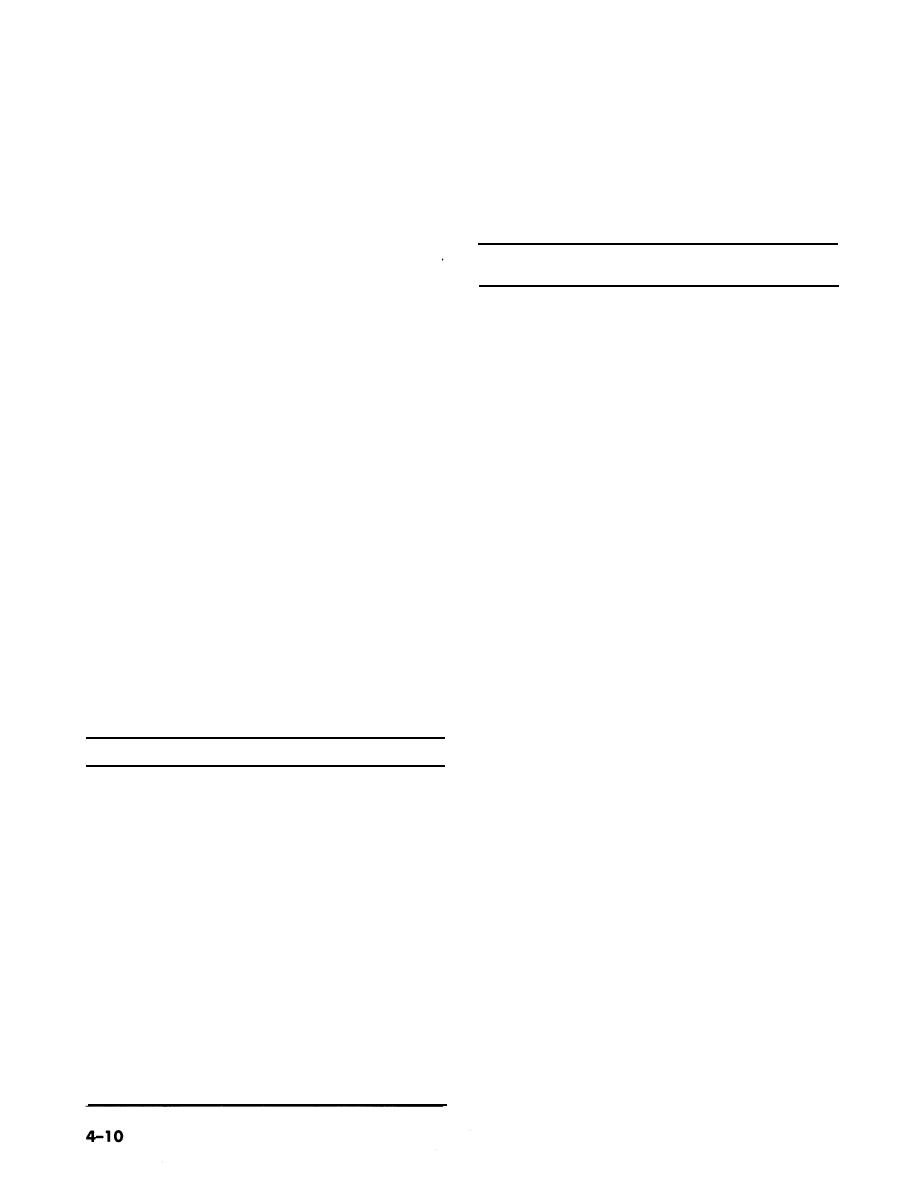

Custom Search
|
|

|
||
 TM 5-685/NAVFAC MO-912
d. Troubleshooting. Perform general trouble-
h. Industrial practices. Use recognized industrial
shooting of the equipment (as outlined in the follow-
practices as the general guide for generator system
ing table) if a problem develops. Refer to the manu-
servicing.
facturer's literature for repair information after
diagnosis.
should refer to manufacturer's literature for specific
information on individual units.
Table 4-2. Generator trouble shooting.
4-12. Generator maintenance.
NOISY OPERATION
a. Service and troubleshooting. Service consists of
Remedy
Cause
performing basic and preventive maintenance
checks that are outlined below. If troubles develop
Balance load and check alignment
Unbalanced load or coupling
or if these actions do not correct a problem, refer to
misalignment
the troubleshooting table 4-1. Maintenance person-
Center rotor by replacing or
Air gap not uniform
nel must remember that the manufacturer's litera-
shimming bearings
ture supersedes the information provided herein.
Tighten coupling
Coupling loose
b. Operational check. Check the equipment dur-
ing operation and observe the following indications.
OVERHEATING
(1) Unusual noises or noisy operation may in-
Balance load
Electrical load unbalanced
dicate excessive bearing wear or faulty bearing
Replace line fuse
Open line fuse
alignment. Shut down and investigate.
(2) Equipment overheats or smokes. Shut
Clean, remove obstructions
Restricted ventilation
down and investigate.
Repair or replace defective coil
Rotor winding shorted. opened or
(3) Equipment brushes spark frequently. Occa-
grounded
sional sparking is normal, but frequent sparking
Repair or replace defective coil
Stator winding shorted, opened or
indicates dirty commutator and/or brush or brush
grounded
spring defects. Shut down and investigate.
Dry bearings
Lubricate
c. Preventive maintenance. Inspect the equipment
Verify design flow rate: repair or
Insufficient heat transfer of cooler
as described once a month. Maintenance personnel
replace
unit
should make a check list suited to their particular
needs. The actions listed in table 4-l are provided
NO OUTPUT VOLTAGE
as a guide and may be modified. Refer to manufac-
Repair or replace coil
Stator coil open or shorted
turer's instructions.
Repair or replace coils
Rotor coils open or shorted
Table 4-l. Generator inspection list.
Repair as directed by manufacturer
Shorted sliprings
Dry winding
Internal moisture (indicated by
Inspect
Check For
low-resistance reading on megger)
Amount of wear, Improper wear, Spring
Brushes
Replace
Voltmeter defective
Tension
Replace ammeter and shunt
Ammeter shunt open
Dirt, Amount of wear, Loose leads, Loose
Commutator
OUTPUT VOLTAGE UNSTEADY
bars
Clean slip rings and reseat
Poor commutation
Grooves or wear. Dirt, carbon, and/or
Collector Rings
brushes
copper accumulation. Greenish coating
(verdigris)
Clean and tighten all contacts
Loose terminal connections
Damaged insulation. Measure and record
Insulation
Adjust voltage regulator and
Fluctuating load
insulation resistance.
governor speed
Dust and dirt, Loose windings or
Windings
OUTPUT VOLTAGE TOO HIGH
connections
Adjust voltage regulator
Over-excited
Loose shaft or excessive endplay.
Bearings
Vibration (defective bearing)
Replace or repair defective coils
One leg of delta-connected stator
open
Lubricant leakage, Dirt or sludge in oil
Bearing Housing
(sleeve bearings)
FREQUENCY INCORRECT OF FLUCTUATING
Obstruction of air ducts or screens. Loose
Ventilation and cooling
Adjust speed-governing device
Speed incorrect or fluctuating
or bent fan blades
system
|
 |
|
 |
||